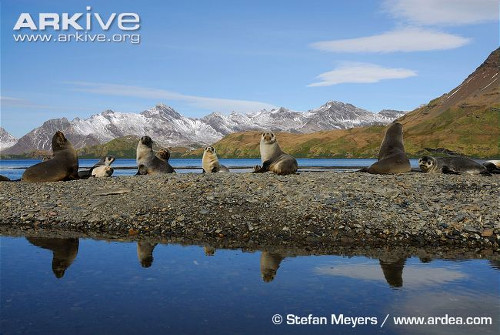Sample menu:
Antarctic Fur seal (Arctocephalus gazella) breeding success in the context of climate change.

The project
of Individual based modelling of
the project MyctO-3D-map (supported by the French National Research
Agency) concentrated on the success of the breeding period (from birth
to weaning) of large marine predators of the Subantarctic zones.
animation : localization of the colony (Cap Noir)
More
exactly, we were interested, among others, in the fur seals of
Kerguelen (or the Antarctic fur seal: Arctocephalus
gazella) who come to reproduce in
colonies in the archipelago of the same name. These animals are
carnivores and feed very preferentially, in this region, on lantern
fishes (Myctophideae) which migrate towards the surface at
night. After having given birth by the beginning of December, females
proceed to their first feeding and then
alternate stays at sea (5 in 7 days on average) to feed with short
stays in the colony. This phase lasts
approximately 4 months at the end of which the pups
are weaned and start their autonomous life.
MarCPFS is a simulator which attempt to reproduce these phases including a prenatal period of exploration of the neighborhood of the Kerguelen Islands during which fur seals will memorize the richest zones which they discover, so as to begin the period of breeding in the best conditions to feed. The time step of the simulator is the hour.
The simulator involves stochastic elements, in particular in the decision-making problems of the seals: the decision to leave the island or to return there, to dive and fish or to continue foraging somewhere else, the return with fidelity to the memorized zone, etc.
For each fur seal, bio-energetic parameters are regularly updated according to the fishing success, the lactation, the hourly metabolic loss... Are also calculated in the initialization some parameters which characterize the animal. So, according to her size are calculated the drag force the mother seal has to face (for an average speed of travel of 2 ms-1) and the maximal energy she can potentially acquire.
The seals move in a 2 dimensional and fixed environment (a map of density of the resources). The resource is distributed in a radius of 500 km around the island. Three parameters are taken into account in their creation: the average density (from 90 to 360 g of capturables prey in one hour of dive), the aggregation of the resource (from scattered to highly aggregated) and the distance island-resource, that is the distance in which the probability to find zones of maximal density is 1. Maps thus present a positive gradient of density of the resource when moving away from the island.
Environmental conditions and characteristic traits of the fur seals (body size, memorization ability, type of movements) condition the breeding success. However, environmental conditions and traits can counterbalance partially and so reveal emergent phenomena in the results.
For further details, please refer to the following publication and the Supplementary Information attached to the paper:
Massardier-Galatà L, Morinay J, Bailleul F, Wajnberg E, Guinet C, Coquillard P (2017) Breeding success of a marine central place forager in the context of climate change: A modeling approach. PLoS ONE 12(3): e0173797. doi:10.1371/journal.pone.0173797
Results of simulations can be freely viewed and dowloaded through the The MarCPFS database :
http://www2.sophia.inra.fr/MarCPFS_Database/index.php